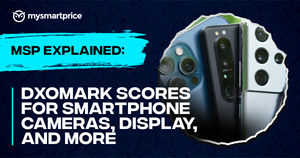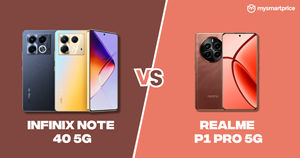
Smartphone makers have been mentioning DXOMARK scores in their offerings. However, have you ever wondered what this DXOMARK is and why it matters so much? If the answer is yes, you have landed at the right place. This is your ultimate guide to understanding DXOMARK. In this MSP Explained article, we have explained everything from what DXOMARK is to understanding its rating and impact. So, without further ado, let’s get started!
What is DXOMARK?
Based in France, DXOMARK is an independent benchmarking platform, which uses scientific methods to assess smartphone cameras, audio, display, and battery capabilities. Lately, the company has also started rating wireless speakers.
DXOMARK started its journey in 2008 by analysing camera sensors and lenses. Later, the company began testing smartphones and other mobile devices and introduced DXOMARK Mobile in 2012, later renamed DXOMARK Camera.
How DXOMARK Tests Smartphones and Other Devices
DXOMARK employs a rigorous testing process to evaluate the smartphone’s performance. It uses a combination of subjective and objective tests to assess the devices, and the tests include.
Smartphone Camera Testing
DXOMARK’s camera testing involves the following aspects of a smartphone camera:
- Exposure and Contrast
- Colour
- Auto-focus
- Texture
- Noise
- Artefacts
- Night (expanded from Flash in September 2019)
- Zoom
- Bokeh
- Wide
- Preview
They also test the device’s video capabilities, including six aspects from the Photo test—Exposure, Colour, Auto-focus, Texture, Noise, and Artefacts—and another category: Stabilisation.
The team at DXOMARK tests the smartphone camera in various lighting conditions, from the very dim 1 Lux to bright outdoor daylight. However, it’s important to remember that these tests are limited to default camera modes, except for Zoom and Bokeh.
The company also tests the smartphone’s front camera for photos and videos. The photo test assesses various factors, including Exposure, Colour, Focus, Texture, Noise, Artefacts, Flash, and Bokeh. Meanwhile, the video test encompasses all these elements and additionally evaluates Stabilisation.
Smartphone Audio Testing
DXOMARK started evaluating the smartphone’s audio capabilities in October 2019. Here, the company tests smartphone speakers and microphones by coinciding the following elements:
- Timbre: This includes frequency response, treble/midrange/bass, total balance, and volume dependency.
- Dynamics: This covers attack, bass precision, punch, and volume dependency.
- Spatial: This assesses wideness, balance, distance, and localisation.
- Volume: This measures maximum and minimum levels and user volume consistency.
- Artefacts: This involves noise, pumping, clipping, user artefacts, and other unwanted audio distortions.
Furthermore, when testing the microphone on the device, DXOMARK only evaluates the background by evaluating directivity, noise profile, and device artefacts.
Smartphone Display Testing
DXOMARK tests smartphone displays using a combination of objective and perceptual methods. Objective tools measure colour accuracy, brightness, and contrast, making sure that the claimed technical specifications meet high standards. It includes evaluating frame drops, motion blur and judder at different frame rates.
Additionally, the company tests the auto-brightness capabilities in different lighting conditions. DXOMARK also assesses the motion interpolation algorithms to ensure that they generate smooth animations.
On the other hand, perceptual testing evaluates displays in various scenarios, such as web browsing, night reading, in-car navigation, taking photos, viewing photos, gaming, and watching movies.
This testing is conducted under a range of ambient light levels, from near-pitch darkness to bright daylight, to simulate real-world usage. The testing environment is controlled using a custom-built chamber and an advanced laboratory, ensuring consistent and accurate results.
Smartphone Battery Testing
When it comes to testing the smartphone’s battery, they basically check how long a phone lasts on a single charge and how quickly it charges back up. DXOMARK do this in two ways:
- Machine tests: These tests try to mimic how a smartphone is used in real-world situations. They include web browsing or gaming to see how long the battery lasts. They also check how fast the phone charges and how much power different parts of the phone use.
- Real-person tests: These check how well the battery indicator on the device matches the actual amount of life left. They also check how much power you get from a quick charge at different battery levels.
DXOMARK uses special tools for both tests to measure the phone’s power and charging speed. They also use the charger that comes with the phone to ensure fairness. Ultimately, they score the phone based on how long it lasts, how fast it charges, and how good the battery meter is.
Wireless Speaker Testing
The company has also started testing wireless speakers using a combination of laboratory tests and extensive perceptual assessments. DXOMARK conducts over 20 hours of evaluation using sound-level meters and calibrated microphones.
Additionally, they utilise customised music clips created in collaboration with professional musicians and recording studios, encompassing genres such as jazz, hip-hop, classical, pop, rock, Latin, electronic, and more.
Understanding DXOMARK Scores
DXOMARK gives scores based on many tests they do. Interestingly, they don’t just add up all the scores from the different tests to get the overall score. Instead, the company has its unique way of combining them. However, the company has not revealed how exactly to determine the main score.
When it comes to the scores themselves, there’s no clear limit to how high they can go. At first, it seemed like the highest score one could get was 100, but now, many high performers are getting scores even higher than that.
Do DXOMARK Ratings Matter?
DXOMARK ratings have a tremendous influence on both customers and manufacturers. High scores can influence consumer preferences, purchase decisions, and market trends. On the other hand, manufacturers use these scores to emphasise the advantages of their products.
However, much like benchmark scores are not meant to be the sole reason for considering a device, DXMOMARK scores are not the only deciding factor. You should always consider your needs and of course, the budget before buying a smartphone, an audio product, or a camera. These scores lend help to know how a device is compared to the competition.


















